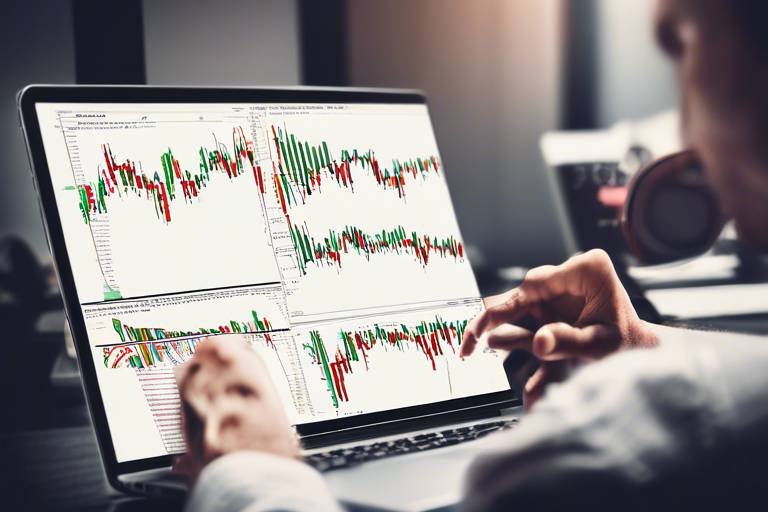Understanding the Bid-Ask Spread in Crypto Trading
In the fast-paced world of cryptocurrency trading, understanding the bid-ask spread is essential for anyone looking to navigate the market successfully. The bid-ask spread is not just a technical term; it’s a crucial concept that can significantly impact your trading experience and profitability. Imagine you’re at a market, and you want to buy a fresh apple. The seller has a price they’re willing to accept (the ask), while you have a price you’re willing to pay (the bid). The difference between these two prices is the spread. In the realm of crypto, this spread can fluctuate wildly, influenced by various factors, and understanding it can be the key to making informed trading decisions.
The bid-ask spread represents the difference between the highest price a buyer is willing to pay for a cryptocurrency (the bid) and the lowest price a seller is willing to accept (the ask). It’s like the gap between a handshake deal and a signed contract. In crypto trading, this spread is a vital indicator of market health and liquidity. When the spread is narrow, it typically indicates a more liquid market, making it easier to buy or sell assets without significant price fluctuations. Conversely, a wider spread can signal lower liquidity and higher transaction costs for traders.
Understanding the bid-ask spread is crucial for traders as it directly affects transaction costs and market liquidity. A tight spread means you can buy and sell at prices that are closer together, which can enhance your profitability. On the other hand, a wider spread can eat into your profits, especially if you’re making frequent trades. Here are a few reasons why the bid-ask spread matters:
- Cost of Trading: The spread is essentially a cost that traders incur. The wider the spread, the more you pay to enter and exit trades.
- Market Sentiment: A widening spread can indicate uncertainty or volatility in the market, while a narrow spread often reflects confidence among traders.
- Liquidity: A narrow spread typically signifies a liquid market, allowing traders to execute trades more easily.
Several factors can significantly impact the bid-ask spread, affecting traders' decisions. Understanding these factors can provide insight into market dynamics:
High market volatility often leads to wider spreads. When prices are fluctuating rapidly, sellers may demand a higher price to compensate for the risk, while buyers may lower their bids. This can increase costs for traders and impact their ability to execute profitable trades effectively. Think of it like a roller coaster; the more twists and turns, the less predictable the ride becomes.
Higher trading volumes typically result in narrower spreads. Increased activity enhances liquidity, allowing traders to buy and sell without significantly affecting the price. It’s like a bustling marketplace; the more people there are, the easier it is to find someone willing to make a deal.
Different types of cryptocurrency markets, such as centralized exchanges and decentralized exchanges, exhibit varying bid-ask spreads. Centralized exchanges often have tighter spreads due to higher liquidity and trading volume, while decentralized exchanges may experience wider spreads due to lower activity levels. This distinction can influence traders' choices, as they may prefer one type of market over another based on their trading strategy and goals.
Traders can analyze the bid-ask spread by observing historical data and current market conditions. This analysis enables better decision-making in their trading strategies. By keeping an eye on the spread, traders can identify trends and make informed predictions about future price movements.
Technical indicators can help traders assess the bid-ask spread's trends and patterns. Indicators like the Average True Range (ATR) can provide insights into market volatility, while moving averages can help identify when spreads are narrowing or widening. This knowledge can be invaluable in spotting potential trade opportunities.
Real-time monitoring of the bid-ask spread allows traders to make informed decisions quickly. In fast-moving markets, being able to react promptly can be the difference between profit and loss. Tools and platforms that provide live data on spreads can enhance traders' ability to optimize their strategies and seize opportunities as they arise.
Traders can employ various strategies to minimize costs associated with the bid-ask spread, enhancing their overall trading efficiency and profitability. Here are a couple of effective approaches:
Understanding the differences between limit orders and market orders can help traders choose the best approach to reduce the impact of the bid-ask spread on their trades. A limit order allows you to set the price at which you want to buy or sell, which can help avoid the costs associated with a wide spread. In contrast, a market order executes immediately at the current market price, which may expose you to a wider spread.
Timing your trades during periods of lower volatility can help you benefit from narrower spreads. By observing market trends and trading patterns, you can identify the best times to enter or exit trades, ultimately reducing your transaction costs and improving profitability.
Q1: What is a good bid-ask spread?
A good bid-ask spread varies by cryptocurrency and market conditions, but generally, a narrow spread (a few cents or less) indicates a healthy, liquid market.
Q2: How can I find the bid-ask spread for a cryptocurrency?
You can find the bid-ask spread on most trading platforms or exchanges, which typically display both the highest bid and the lowest ask prices.
Q3: Does the bid-ask spread affect long-term investors?
While long-term investors may not be as impacted by the spread as day traders, it still affects the overall cost of buying and selling assets.

What is the Bid-Ask Spread?
The bid-ask spread is a fundamental concept in the world of cryptocurrency trading, serving as a crucial indicator of market dynamics. In simple terms, the bid-ask spread represents the difference between the highest price a buyer is willing to pay (the bid) and the lowest price a seller is willing to accept (the ask). This spread is not just a number; it reflects the liquidity of the market and the trading activity surrounding a particular cryptocurrency.
To illustrate, imagine you're at a bustling market where everyone is trying to buy and sell the latest gadgets. The price you’re willing to pay for that shiny new smartphone is your bid, while the lowest price the seller is willing to let it go for is the ask. The space between these two prices is the bid-ask spread. In the crypto world, this spread can fluctuate widely based on various factors, including market sentiment and trading volume.
Understanding the bid-ask spread is essential for traders because it directly impacts their transaction costs and potential profitability. A narrower spread often indicates a more liquid market, which is more favorable for traders looking to enter or exit positions quickly. Conversely, a wider spread can signal a less liquid market, making it more challenging to execute trades at desired prices. This means that if you're a trader, knowing the bid-ask spread can help you make smarter, more informed decisions.
In the realm of cryptocurrency, the bid-ask spread can vary significantly among different exchanges and even different cryptocurrencies. For instance, major cryptocurrencies like Bitcoin and Ethereum typically exhibit narrower spreads due to their high trading volumes and liquidity. On the other hand, lesser-known altcoins may present wider spreads, reflecting lower demand and trading activity.
To give a clearer picture, here’s a simple table illustrating how the bid-ask spread can vary across different cryptocurrencies:
| Cryptocurrency | Bid Price | Ask Price | Bid-Ask Spread |
|---|---|---|---|
| Bitcoin (BTC) | $40,000 | $40,100 | $100 |
| Ethereum (ETH) | $2,500 | $2,550 | $50 |
| Shiba Inu (SHIB) | $0.00009 | $0.00010 | $0.00001 |
As you can see from the table, the bid-ask spread varies not only by the cryptocurrency itself but also by the trading conditions at the time. Traders should keep a keen eye on these spreads as they can significantly affect the costs associated with buying and selling cryptocurrencies.
In conclusion, the bid-ask spread is more than just a number; it’s a vital piece of the trading puzzle that can influence your strategies and outcomes in the crypto market. By understanding what it is and how it works, you can better navigate your trading journey and make decisions that align with your financial goals.

Importance of the Bid-Ask Spread
The bid-ask spread is a fundamental concept in cryptocurrency trading that every trader should grasp. Why is it so important, you ask? Well, the bid-ask spread directly influences the transaction costs and market liquidity, both of which are crucial for making informed trading decisions. When you think about it, the spread acts as a gateway to understanding how efficiently a market operates. A narrow spread often indicates a healthy market where buyers and sellers are in sync, while a wider spread can signal uncertainty or low liquidity.
One of the primary reasons traders need to understand the bid-ask spread is its impact on profitability. Imagine you're trying to sell a cryptocurrency, but the spread is wide. You might find yourself in a situation where you have to sell at a lower price than you'd like, effectively eating into your profits. On the flip side, if the spread is narrow, you can execute trades more effectively, maximizing your potential gains. This is especially important for day traders and scalpers who rely on quick trades to capitalize on small price movements.
Additionally, the bid-ask spread serves as an indicator of market sentiment. A widening spread may suggest that traders are becoming more cautious, perhaps due to impending news or market events. Conversely, a narrowing spread can indicate increased confidence among traders, often leading to more aggressive buying or selling. Understanding these dynamics can give you a significant edge in your trading strategy.
To illustrate the importance of the bid-ask spread, consider the following table:
| Market Condition | Bid Price | Ask Price | Spread |
|---|---|---|---|
| High Liquidity | $100 | $100.50 | $0.50 |
| Low Liquidity | $95 | $105 | $10 |
As you can see from the table, a high liquidity market has a much narrower spread compared to a low liquidity market. This difference can significantly affect your trading outcomes. Thus, understanding and monitoring the bid-ask spread should be an integral part of your trading strategy.
In summary, the bid-ask spread is not just a mere number; it encapsulates the essence of market dynamics. By keeping an eye on the spread, you can better navigate the complexities of cryptocurrency trading, making smarter decisions that align with your trading goals.
- What is the bid-ask spread? The bid-ask spread is the difference between the highest price a buyer is willing to pay and the lowest price a seller will accept.
- Why is the bid-ask spread important? It affects transaction costs, market liquidity, and overall trading strategies, directly impacting profitability.
- How can I minimize the impact of the bid-ask spread? Using limit orders, timing trades during lower volatility, and choosing the right exchanges can help minimize spread costs.

Factors Influencing the Spread
The bid-ask spread in cryptocurrency trading is not a static figure; rather, it's influenced by a variety of factors that can change rapidly. Understanding these elements can empower traders to make more informed decisions. One major factor is market volatility. When prices swing dramatically, the spread tends to widen, making it more expensive for traders to enter or exit positions. Think of it like a crowded marketplace where sellers are hesitant to drop their prices when they see potential buyers rushing in; they want to ensure they get the most out of their sale.
Another significant factor is trading volume. In times of high trading activity, the bid-ask spread generally narrows. Why? Because more participants in the market mean more liquidity, allowing buyers and sellers to meet at more favorable prices. Imagine a bustling bazaar where the more people you have, the easier it is to strike a deal. Conversely, in quieter markets, spreads can widen, leading to increased transaction costs.
Additionally, the type of cryptocurrency being traded plays a crucial role. Major cryptocurrencies like Bitcoin and Ethereum usually have tighter spreads due to their popularity and higher trading volumes. In contrast, lesser-known altcoins may exhibit wider spreads, reflecting their lower liquidity and trading activity. This discrepancy can be likened to shopping at a well-known brand store versus a small, local shop; the former often has more competitive pricing due to higher demand.
Moreover, external factors such as market news, regulatory changes, and overall sentiment can also impact the bid-ask spread. For instance, if a major announcement shakes up the market, traders might rush to buy or sell, leading to rapid changes in the spread. It's like a sudden storm that causes chaos in a calm sea; everything can shift in an instant.
In summary, understanding these factors is essential for any trader looking to navigate the complex waters of cryptocurrency trading effectively. By keeping an eye on market volatility, trading volume, and the specific cryptocurrencies involved, traders can better anticipate changes in the bid-ask spread and adjust their strategies accordingly.
- What is the bid-ask spread? The bid-ask spread is the difference between the highest price a buyer is willing to pay and the lowest price a seller will accept.
- Why is the bid-ask spread important? It affects transaction costs and market liquidity, influencing trading strategies and profitability.
- How can I minimize spread costs? Strategies include using limit orders, timing trades during lower volatility, and staying informed about market conditions.

Market Volatility
Market volatility is a term that often sends shivers down the spine of even the most seasoned traders. Imagine trying to balance on a tightrope while the wind is howling; that’s what trading feels like during volatile periods. In the world of cryptocurrency, volatility is not just common; it’s practically a way of life. So, what does this mean for the bid-ask spread? Well, when the market is experiencing high volatility, the bid-ask spread tends to widen significantly. This occurs because buyers and sellers are less certain about the future price movements, leading to a greater difference between what buyers are willing to pay and what sellers are willing to accept.
To put it simply, think of the bid-ask spread as a rubber band stretched tight. When the market is calm, the rubber band is relatively short, indicating a narrow spread. However, during periods of high volatility, that rubber band gets stretched, resulting in a wider spread. This can increase transaction costs for traders, making it more challenging to execute profitable trades. The widening spread can be a double-edged sword; while it may deter some traders from entering the market, it also creates opportunities for others who are willing to navigate the turbulent waters.
Moreover, the impact of market volatility on the bid-ask spread can be influenced by several factors, including:
- News Events: Major announcements, regulatory changes, or technological advancements can trigger drastic price movements.
- Market Sentiment: If traders are feeling optimistic or pessimistic, it can lead to rapid buying or selling, affecting the spread.
- Liquidity Levels: In less liquid markets, even small trades can cause significant price swings, widening the spread.
In essence, understanding how market volatility influences the bid-ask spread is crucial for any trader looking to maximize their profitability. By keeping an eye on market conditions and adjusting strategies accordingly, traders can better position themselves to take advantage of the opportunities that arise during these unpredictable times.
Q: What is market volatility?
A: Market volatility refers to the rate at which the price of an asset, like cryptocurrency, increases or decreases for a given set of returns. High volatility means that the price can change dramatically in a short period, which can affect trading strategies.
Q: How does market volatility affect the bid-ask spread?
A: During periods of high volatility, the bid-ask spread tends to widen due to increased uncertainty among buyers and sellers regarding future price movements.
Q: Can I profit from trading during volatile markets?
A: Yes, many traders seek to profit from volatility by employing various strategies, such as short-term trading or using options. However, it is essential to be cautious, as volatility can also lead to significant losses.

Trading Volume
The concept of is pivotal in the realm of cryptocurrency trading, as it directly influences the bid-ask spread. Essentially, trading volume refers to the total number of assets that are traded over a specific period, and it acts as a barometer of market activity. When trading volumes are high, it usually indicates a robust market where many participants are buying and selling, which can lead to narrower spreads. Think of it like a bustling marketplace; the more buyers and sellers there are, the easier it is to find someone willing to match your price. Conversely, when trading volume is low, the market can feel more like a quiet alleyway, where finding a willing counterparty becomes a challenge, resulting in wider spreads.
To illustrate the impact of trading volume on the bid-ask spread, let’s consider a simple example. Imagine a popular cryptocurrency like Bitcoin. During peak trading hours, when thousands of transactions are happening every minute, the bid-ask spread might be as low as $10. However, during off-peak hours, when fewer traders are active, that spread could widen to $50 or more. This fluctuation can significantly affect a trader's profitability, as the costs of entering and exiting positions can vary dramatically based on market activity.
Moreover, the type of trading platform also plays a role in how trading volume affects the bid-ask spread. Centralized exchanges, which often have higher trading volumes due to their user-friendly interfaces and liquidity, typically exhibit narrower spreads. On the other hand, decentralized exchanges may experience lower volumes, leading to wider spreads. This is an important consideration for traders when choosing where to execute their trades.
In summary, understanding the relationship between trading volume and the bid-ask spread is essential for anyone involved in cryptocurrency trading. By keeping an eye on volume trends, traders can make more informed decisions, optimize their entry and exit points, and ultimately enhance their trading performance. It's like navigating a river; knowing when the current is strong can help you paddle more effectively and reach your destination faster.
- What is the bid-ask spread?
The bid-ask spread is the difference between the highest price a buyer is willing to pay and the lowest price a seller will accept. - How does trading volume affect the bid-ask spread?
Higher trading volumes typically lead to narrower spreads, while lower volumes can result in wider spreads. - What are the implications of a wider bid-ask spread?
A wider spread increases transaction costs for traders, making it more difficult to execute profitable trades. - How can I monitor trading volume?
Traders can use various market analysis tools and platforms that provide real-time data on trading volume.

Types of Markets
The world of cryptocurrency trading is as diverse as the currencies themselves, and understanding the different types of markets is essential for any trader looking to navigate this dynamic landscape. In essence, the types of markets can be categorized into two main groups: centralized exchanges (CEX) and decentralized exchanges (DEX). Each type has its unique characteristics, advantages, and disadvantages that can significantly influence the bid-ask spread and overall trading experience.
Centralized exchanges are platforms where transactions occur through a central authority, which acts as an intermediary between buyers and sellers. Think of it as a bustling marketplace where a broker helps you find your desired product. These exchanges typically offer high liquidity, which often leads to narrower bid-ask spreads. However, they also come with certain risks such as hacking incidents and regulatory scrutiny. Popular examples of centralized exchanges include Binance, Coinbase, and Kraken.
On the other hand, decentralized exchanges operate without a central authority, allowing users to trade directly with one another. This model is akin to a peer-to-peer marketplace, where you can buy and sell items directly with other individuals. DEXs often provide greater privacy and security since users retain control of their funds and personal data. However, they can experience lower liquidity, which may result in wider bid-ask spreads. Notable decentralized exchanges include Uniswap, SushiSwap, and Curve Finance.
To illustrate the differences in bid-ask spreads between these two types of markets, consider the following table:
| Market Type | Liquidity | Bid-Ask Spread | Security |
|---|---|---|---|
| Centralized Exchange | High | Narrow | Moderate (subject to hacks) |
| Decentralized Exchange | Variable | Wider | High (user-controlled) |
In summary, the choice between centralized and decentralized exchanges can significantly impact a trader's experience, especially concerning the bid-ask spread. While centralized exchanges may offer more favorable spreads due to higher liquidity, decentralized exchanges provide an appealing alternative for those prioritizing security and privacy. Ultimately, understanding these market types allows traders to make informed decisions tailored to their unique trading strategies and risk tolerance.
- What is the difference between centralized and decentralized exchanges?
Centralized exchanges are managed by a central authority, offering high liquidity but potential security risks. Decentralized exchanges operate peer-to-peer, providing greater privacy and security but often at the cost of liquidity.
- How does the bid-ask spread affect trading?
The bid-ask spread directly impacts transaction costs for traders. A narrower spread means lower costs, while a wider spread can eat into profits, making it essential for traders to consider when choosing where to execute their trades.
- Can I trade on both types of exchanges?
Absolutely! Many traders use both centralized and decentralized exchanges to leverage the benefits of each, depending on their trading strategy and market conditions.

How to Analyze the Bid-Ask Spread
Analyzing the bid-ask spread is a fundamental skill every cryptocurrency trader should master. It's not just about knowing the numbers; it's about understanding what those numbers mean for your trading strategy. To effectively analyze the bid-ask spread, traders should observe both historical data and current market conditions. This dual approach allows for a comprehensive view of how spreads behave over time and under varying market circumstances. Think of it like reading the weather forecast before planning a picnic. You wouldn’t want to find out it’s going to rain only after you’ve set up your blanket!
One of the first steps in this analysis is to monitor the bid-ask spread across different exchanges. Each exchange may have varying spreads based on their liquidity and trading volume. For example, a popular exchange with high trading activity might have a narrower spread compared to a lesser-known platform. Traders can use price aggregation tools to compare spreads across multiple exchanges, ensuring they get the best deal possible. By doing this, they can spot opportunities where the spread is particularly tight, which can lead to more profitable trades.
Additionally, understanding the historical trends of the bid-ask spread can provide valuable insights. Traders can analyze how the spread has changed over time, especially during periods of high volatility or significant market events. For instance, if a trader notices that the spread typically widens significantly during major news announcements, they might choose to adjust their trading strategy accordingly. This historical perspective acts like a compass, guiding traders through the often tumultuous waters of cryptocurrency trading.
Another essential aspect of analyzing the bid-ask spread is real-time monitoring. In the fast-paced world of crypto, prices can change in the blink of an eye. Utilizing trading platforms that offer real-time data is crucial. Traders should set up alerts for when the spread exceeds a certain threshold or when it falls below their target level. This proactive approach allows traders to react swiftly to market changes, optimizing their trades and potentially enhancing profitability.
To summarize, analyzing the bid-ask spread involves:
- Monitoring spreads across different exchanges for better pricing.
- Studying historical trends to anticipate future movements.
- Employing real-time monitoring tools to make informed decisions quickly.
By integrating these practices into their trading routine, traders can make more informed decisions, reduce transaction costs, and ultimately improve their overall trading performance.
What is the bid-ask spread?
The bid-ask spread is the difference between the highest price a buyer is willing to pay (the bid) and the lowest price a seller will accept (the ask) in a market. It's a key indicator of market liquidity and trading costs.
How does the bid-ask spread affect trading?
A wider bid-ask spread can increase trading costs and reduce profitability. Understanding and analyzing the spread helps traders make better decisions and find more favorable trading conditions.
Can I reduce the impact of the bid-ask spread?
Yes! Traders can employ strategies such as using limit orders instead of market orders and timing their trades during periods of lower volatility to minimize the impact of the spread.

Using Technical Indicators
When it comes to navigating the choppy waters of cryptocurrency trading, technical indicators serve as invaluable tools for traders. These indicators help in assessing the bid-ask spread's trends and patterns, which can be a game-changer in identifying potential market movements. Imagine trying to find your way through a dense forest without a map; technical indicators are like that map, guiding you through the twists and turns of the market.
One of the primary benefits of using technical indicators is their ability to provide visual representations of data. By analyzing graphs and charts, traders can spot trends that may not be immediately obvious. For instance, moving averages can help smooth out price fluctuations, making it easier to identify whether the market is trending upwards or downwards. This clarity can help traders make informed decisions about when to enter or exit a trade.
Additionally, there are several types of technical indicators that traders can utilize to analyze the bid-ask spread effectively. Some popular indicators include:
- Relative Strength Index (RSI): This momentum oscillator measures the speed and change of price movements. It can indicate overbought or oversold conditions, helping traders gauge potential reversals.
- Bollinger Bands: These bands expand and contract based on market volatility, giving traders insight into potential price breakouts or reversals.
- Moving Averages: By averaging prices over a specific period, moving averages can help smooth out short-term fluctuations, allowing traders to focus on longer-term trends.
Moreover, combining multiple indicators can yield even more powerful insights. For example, a trader might use the RSI to identify overbought conditions and then confirm this with a Bollinger Band breakout. This multi-faceted approach can significantly enhance a trader's decision-making process, providing a more comprehensive view of the market.
However, it’s essential to remember that no indicator is foolproof. Market conditions can change rapidly, and relying solely on technical indicators without considering other factors can lead to poor trading decisions. Therefore, it’s advisable to combine technical analysis with fundamental analysis and market news to create a well-rounded trading strategy.
In conclusion, using technical indicators is a vital aspect of analyzing the bid-ask spread in cryptocurrency trading. They offer traders a structured way to interpret market data and make informed decisions. Just like a seasoned sailor relies on navigational tools to steer through turbulent seas, traders can harness the power of technical indicators to navigate the complex world of crypto trading successfully.
- What are technical indicators? Technical indicators are mathematical calculations based on price, volume, or open interest of a security, used by traders to forecast future price movements.
- How do I choose the right technical indicator? The choice of technical indicators depends on your trading strategy, market conditions, and personal preferences. It's often beneficial to experiment with various indicators to see which ones work best for you.
- Can technical indicators guarantee profits? While technical indicators can enhance your trading strategy, they do not guarantee profits. It's crucial to use them in conjunction with other analysis tools and risk management strategies.

Real-Time Monitoring
In the fast-paced world of cryptocurrency trading, of the bid-ask spread is not just an option; it's a necessity. Imagine trying to catch a wave while surfing—if you're not paying attention to the ocean's movements, you might miss the perfect swell. Similarly, in crypto trading, the dynamic nature of the market demands that traders stay alert to changes in the bid-ask spread. This constant vigilance allows traders to seize opportunities and avoid pitfalls, ensuring they remain competitive in a landscape where every second counts.
Real-time monitoring can be accomplished through various tools and platforms that provide live data feeds. These tools can display the current bid and ask prices, as well as the spread, allowing traders to make quick decisions. Think of it as having a GPS while navigating through a busy city; it helps you avoid traffic jams and find the best routes to your destination. With the right monitoring tools, traders can assess whether the spread is widening or narrowing, which can indicate market sentiment and potential price movements.
Moreover, many traders utilize technical analysis alongside real-time monitoring to enhance their decision-making processes. By combining live data with historical trends, they can identify patterns that may suggest when to enter or exit a trade. For instance, if the spread begins to widen significantly, it might signal increased volatility, prompting traders to act swiftly. Conversely, a narrowing spread could indicate a stable market, presenting an opportunity for profitable trades.
To illustrate the impact of real-time monitoring, consider the following table that compares the bid-ask spread under different market conditions:
| Market Condition | Bid Price | Ask Price | Bid-Ask Spread |
|---|---|---|---|
| High Volatility | $45,000 | $46,500 | $1,500 |
| Low Volatility | $45,000 | $45,250 | $250 |
| High Trading Volume | $45,100 | $45,150 | $50 |
| Low Trading Volume | $45,000 | $46,000 | $1,000 |
This table highlights how the bid-ask spread can fluctuate based on market conditions. Traders who monitor these changes in real-time can adjust their strategies accordingly, whether that means placing a trade quickly or holding off until conditions improve. In essence, real-time monitoring is like having a pulse on the market, providing traders with the insights needed to navigate the complexities of crypto trading effectively.
- What is the bid-ask spread? The bid-ask spread is the difference between the highest price a buyer is willing to pay and the lowest price a seller will accept.
- How does the bid-ask spread affect trading? A wider spread can increase transaction costs, while a narrower spread can enhance trading efficiency and profitability.
- Why is real-time monitoring important? It allows traders to make quick decisions based on current market conditions, helping them to capitalize on opportunities and avoid losses.
- What tools can I use for real-time monitoring? Many trading platforms offer built-in tools for monitoring the bid-ask spread, including charts and live data feeds.

Strategies to Minimize Spread Costs
When it comes to trading cryptocurrencies, one of the most significant factors that can eat into your profits is the bid-ask spread. Thankfully, there are several strategies you can employ to minimize these costs and enhance your trading experience. Think of it like navigating through a crowded marketplace; the better you understand the layout and the best times to shop, the more you can save. Here are some effective strategies to consider:
One of the most straightforward methods to minimize spread costs is by using limit orders instead of market orders. A limit order allows you to set a specific price at which you're willing to buy or sell a cryptocurrency, ensuring that you won't pay more than you're comfortable with. In contrast, a market order executes immediately at the current market price, which can often be higher than your desired price due to the spread. By placing limit orders, you can strategically wait for the market to come to you, potentially saving a significant amount in spread costs.
Additionally, timing your trades can be crucial. Markets often experience fluctuations in volatility throughout the day. During periods of lower volatility, spreads tend to narrow, making it an ideal time to execute trades. By monitoring the market and identifying these calm periods, you can significantly reduce your transaction costs. Think of it like shopping during a sale; if you know when the discounts are happening, you can save a lot more!
Another strategy is to focus on trading pairs with higher liquidity. Liquidity refers to how easily an asset can be bought or sold in the market without affecting its price. Pairs with higher trading volumes generally have narrower spreads, making them more cost-effective for trading. For example, popular cryptocurrencies like Bitcoin and Ethereum often exhibit better liquidity compared to lesser-known altcoins. By concentrating your trading efforts on these more liquid pairs, you can minimize the impact of the bid-ask spread.
Moreover, utilizing real-time monitoring tools can provide you with a significant edge. Many trading platforms offer advanced charting tools and analytics that allow you to keep an eye on the bid-ask spread in real time. By staying informed, you can make quick decisions and enter or exit positions at the best possible prices. It’s like having a GPS in your trading journey; it helps you navigate the market more efficiently and avoid unnecessary costs.
Lastly, consider employing a trading strategy that includes frequent analysis of the bid-ask spread. By keeping track of historical data and current market trends, you can identify patterns that may indicate when to trade. This analytical approach allows you to make more informed decisions, ultimately enhancing your profitability. You can think of this as studying your favorite sports team; the more you know about their performance, the better you can predict their next move!
Q: What is the bid-ask spread?
A: The bid-ask spread is the difference between the highest price a buyer is willing to pay (bid) and the lowest price a seller will accept (ask) in a trading market.
Q: Why is the bid-ask spread important?
A: The bid-ask spread is crucial because it affects transaction costs and market liquidity, influencing overall trading strategies and profitability.
Q: How can I minimize the bid-ask spread costs?
A: You can minimize costs by using limit orders, timing your trades during lower volatility, focusing on liquid trading pairs, utilizing real-time monitoring tools, and analyzing historical data.

Limit Orders vs. Market Orders
When it comes to trading cryptocurrencies, one of the most critical decisions you'll face is whether to use limit orders or market orders. Each type of order has its own unique advantages and disadvantages that can significantly influence your trading experience and outcomes. So, what exactly are these orders, and how can they help you navigate the often turbulent waters of crypto trading?
A market order is the simplest type of order. When you place a market order, you're essentially telling the exchange, "Buy this cryptocurrency for me at the best available price right now!" This type of order guarantees that your trade will be executed quickly, which is perfect for traders who want to take advantage of sudden price movements. However, the downside is that you might end up paying a higher price than you anticipated, especially if the market is volatile. This is where the bid-ask spread plays a crucial role, as executing a market order could mean buying at the ask price, which might be significantly higher than the last traded price.
On the other hand, a limit order allows you to set a specific price at which you're willing to buy or sell a cryptocurrency. For example, if you believe that Bitcoin is currently overpriced at $50,000 and you only want to buy it at $48,000, you can place a limit order at that price. This means your order will only execute if the market reaches your desired price. While this can help you avoid the pitfalls of buying at a higher price, there's no guarantee that your order will be filled, especially if the market never hits your target price. In this way, limit orders can be seen as a double-edged sword—they offer control but come with the risk of missing out on potential trades.
To illustrate the differences between these two types of orders, consider the following table:
| Order Type | Execution Speed | Price Control | Risk of Not Executing |
|---|---|---|---|
| Market Order | Fast | Low | None |
| Limit Order | Variable | High | Yes |
Choosing between limit and market orders often comes down to your trading strategy and risk tolerance. If you're a trader who values speed and is willing to accept a potentially higher price, market orders might be your go-to choice. However, if you prefer to have a tighter grip on your trading prices and are okay with waiting for the market to come to you, limit orders could be the better option.
In conclusion, understanding the nuances of limit and market orders is essential for any trader looking to optimize their trading strategy. Both have their place in the market, and knowing when to use each can make a significant difference in your overall trading success.
- What is a limit order? A limit order allows you to specify the price at which you want to buy or sell a cryptocurrency, ensuring that you don’t pay more than you intend.
- What is a market order? A market order buys or sells a cryptocurrency at the best available price in the market, ensuring quick execution but less control over the price.
- Which order type should I use? It depends on your trading goals. Use market orders for quick trades and limit orders for price control.
- Can I change a limit order after placing it? Yes, most exchanges allow you to modify or cancel limit orders as long as they haven't been executed yet.

Timing the Market
This article explores the concept of the bid-ask spread in cryptocurrency trading, its significance, and how it impacts traders' decisions and market dynamics.
The bid-ask spread represents the difference between the highest price a buyer is willing to pay and the lowest price a seller will accept in crypto trading.
Understanding the bid-ask spread is crucial for traders as it directly affects transaction costs and market liquidity, influencing overall trading strategies and profitability.
Several factors, including market volatility, trading volume, and the type of cryptocurrency, can significantly impact the bid-ask spread, affecting traders' decisions.
High market volatility often leads to wider spreads, increasing costs for traders and impacting their ability to execute profitable trades effectively.
Higher trading volumes typically result in narrower spreads, as increased activity can enhance liquidity and reduce the costs associated with trading.
Different types of cryptocurrency markets, such as centralized exchanges and decentralized exchanges, exhibit varying bid-ask spreads, influencing traders' choices.
Traders can analyze the bid-ask spread by observing historical data and current market conditions, enabling better decision-making in their trading strategies.
Technical indicators can help traders assess the bid-ask spread's trends and patterns, providing insights into potential market movements and trade opportunities.
Real-time monitoring of the bid-ask spread allows traders to make informed decisions quickly, optimizing their trading strategies in fast-moving markets.
Traders can employ various strategies to minimize costs associated with the bid-ask spread, enhancing their overall trading efficiency and profitability.
Understanding the differences between limit orders and market orders can help traders choose the best approach to reduce the impact of the bid-ask spread on their trades.
Timing the market is like catching a wave; if you can anticipate when the tide is right, you can ride it to greater profits. In the fast-paced world of cryptocurrency trading, knowing when to execute your trades is essential for minimizing the bid-ask spread. The spread can vary significantly throughout the day, influenced by factors such as trading volume and market sentiment. For instance, during peak trading hours, when more buyers and sellers are active, the spread tends to narrow, making it a more favorable time to trade.
On the flip side, during off-peak hours, spreads can widen, leading to higher transaction costs. Therefore, savvy traders often analyze historical data and current trends to identify the best times to enter or exit a position. Utilizing tools like trading bots or alerts can help automate this process, ensuring that you don’t miss out on prime trading opportunities.
Additionally, it's vital to stay updated with market news and events that could impact cryptocurrency prices. Major announcements or changes in regulations can cause sudden spikes in volatility, which might affect the bid-ask spread. By being proactive and timing your trades strategically, you can significantly reduce the costs associated with the bid-ask spread and enhance your overall trading success.
- What is the bid-ask spread? The bid-ask spread is the difference between the highest price a buyer is willing to pay and the lowest price a seller will accept.
- Why is the bid-ask spread important? It affects transaction costs, market liquidity, and can influence trading strategies and profitability.
- How can I minimize spread costs? By using limit orders, timing your trades during lower volatility periods, and monitoring market conditions.
- What factors influence the bid-ask spread? Factors include market volatility, trading volume, and the type of cryptocurrency being traded.
Frequently Asked Questions
- What is the bid-ask spread in crypto trading?
The bid-ask spread is the difference between the highest price a buyer is willing to pay (the bid) and the lowest price a seller will accept (the ask). This spread is crucial as it reflects the liquidity and market dynamics of a cryptocurrency.
- Why is the bid-ask spread important for traders?
Understanding the bid-ask spread is vital for traders because it directly impacts transaction costs and market liquidity. A wider spread can lead to higher costs, making it essential for traders to factor this into their trading strategies to maximize profitability.
- What factors influence the bid-ask spread?
Several factors can influence the bid-ask spread, including market volatility, trading volume, and the specific cryptocurrency being traded. For instance, during periods of high volatility, spreads tend to widen, while higher trading volumes often lead to narrower spreads.
- How can traders analyze the bid-ask spread?
Traders can analyze the bid-ask spread by observing historical data and current market conditions. Utilizing technical indicators can also provide insights into trends and patterns, helping traders make informed decisions about their trades.
- What strategies can help minimize spread costs?
To minimize costs associated with the bid-ask spread, traders can use limit orders instead of market orders, as well as time their trades during periods of lower volatility. These strategies can help reduce transaction costs and improve overall trading efficiency.
- How does the type of market affect the bid-ask spread?
Different types of cryptocurrency markets, such as centralized exchanges and decentralized exchanges, exhibit varying bid-ask spreads. Centralized exchanges often have tighter spreads due to higher liquidity, while decentralized exchanges may have wider spreads due to lower trading volumes.



















